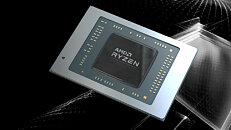- Joined
- Oct 9, 2007
- Messages
- 47,655 (7.43/day)
- Location
- Dublin, Ireland
| System Name | RBMK-1000 |
|---|---|
| Processor | AMD Ryzen 7 5700G |
| Motherboard | Gigabyte B550 AORUS Elite V2 |
| Cooling | DeepCool Gammax L240 V2 |
| Memory | 2x 16GB DDR4-3200 |
| Video Card(s) | Galax RTX 4070 Ti EX |
| Storage | Samsung 990 1TB |
| Display(s) | BenQ 1440p 60 Hz 27-inch |
| Case | Corsair Carbide 100R |
| Audio Device(s) | ASUS SupremeFX S1220A |
| Power Supply | Cooler Master MWE Gold 650W |
| Mouse | ASUS ROG Strix Impact |
| Keyboard | Gamdias Hermes E2 |
| Software | Windows 11 Pro |
AMD's next-generation Ryzen 7000-series "Phoenix" mobile processors are all the rage these days. Bound for 2023, these chips feature a powerful iGPU based on the RDNA3 graphics architecture, with performance allegedly rivaling that of a GeForce RTX 3060 Laptop GPU—a popular performance-segment discrete GPU. What's more, AMD is also taking a swing at Intel in the CPU core-count game, by giving "Phoenix" a large number of "Zen 4" CPU cores. The secret ingredient pushing this combo, however, is a large cache.
AMD has used large caches to good effect both on its "Zen 3" processors, such as the Ryzen 7 5800X3D, where they're called 3D Vertical Cache (3D V-cache); as well as its Radeon RX 6000 discrete GPUs, where they're called Infinity Cache. The only known difference between the two is that the latter is fully on-die, while the former is stacked on top of existing silicon IP. It's being reported now, that "Phoenix" will indeed feature a stacked 3D V-cache.

The exact function of this isn't known—whether it serves as a last-level cache for the CPU or iGPU. AMD's APU architecture differs from Intel's processors that have iGPUs. On the Intel chips, the L3 cache serves as town-square for the entire SoC, with each IP block contributing an L3 cache slice that make up a functionally-contiguous cache that all IP blocks can equally address over the Ring Bus. On AMD APUs such as "Cezanne" or "Rembrandt," the L3 cache is part of the CCX (CPU cores complex), and serves exclusively as last-level cache for the CPU cores. The iGPU has its own LLC, and the Infinity Fabric interconnect is the ether binding all IP blocks on the silicon.
The obvious direction for development in future APUs could be a unification of last-level cache for the CCX and iGPU, provided the cache is large enough for the function—and this can be accomplished by stacked cache. An RDNA2 GPU with performance rivaling the RTX 3060 Laptop GPU, the Radeon RX 6650M XT, based on the "Navi 23" silicon, has 32 MB of Infinity Cache. This means, with some clever cache memory-management, an LLC size in the neighborhood of 64 MB could emerge feasible for the APU.
View at TechPowerUp Main Site | Source
AMD has used large caches to good effect both on its "Zen 3" processors, such as the Ryzen 7 5800X3D, where they're called 3D Vertical Cache (3D V-cache); as well as its Radeon RX 6000 discrete GPUs, where they're called Infinity Cache. The only known difference between the two is that the latter is fully on-die, while the former is stacked on top of existing silicon IP. It's being reported now, that "Phoenix" will indeed feature a stacked 3D V-cache.

The exact function of this isn't known—whether it serves as a last-level cache for the CPU or iGPU. AMD's APU architecture differs from Intel's processors that have iGPUs. On the Intel chips, the L3 cache serves as town-square for the entire SoC, with each IP block contributing an L3 cache slice that make up a functionally-contiguous cache that all IP blocks can equally address over the Ring Bus. On AMD APUs such as "Cezanne" or "Rembrandt," the L3 cache is part of the CCX (CPU cores complex), and serves exclusively as last-level cache for the CPU cores. The iGPU has its own LLC, and the Infinity Fabric interconnect is the ether binding all IP blocks on the silicon.
The obvious direction for development in future APUs could be a unification of last-level cache for the CCX and iGPU, provided the cache is large enough for the function—and this can be accomplished by stacked cache. An RDNA2 GPU with performance rivaling the RTX 3060 Laptop GPU, the Radeon RX 6650M XT, based on the "Navi 23" silicon, has 32 MB of Infinity Cache. This means, with some clever cache memory-management, an LLC size in the neighborhood of 64 MB could emerge feasible for the APU.
View at TechPowerUp Main Site | Source





